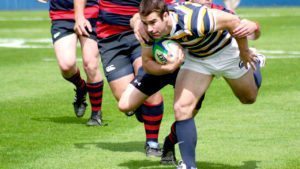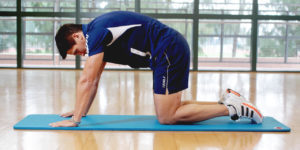How to train around a lower back injury
- Patrick Dale
- Injury Prevention, Training
Lower back pain is very common. In fact, it’s the second most common reason for visits to the doctor’s office. 80% of all working American adults will experience back pain each year. (1)
Despite their all-but legendary toughness, strength and fitness, ruggers are just as likely to suffer back pain as the average desk-jockey. In fact, given the extreme physical demands faced by rugby players both on the pitch and in the gym, back pain is just as common a problem for elite athletes as it is sedentary people. (2)
Heavy deadlifts and squats, high-impact plyometrics, crunching tackles and scrummaging can all take a toll on your spine – a very complex body part. Comprising of 33 bones called vertebrae, intervertebral disks, ligaments, tendons and many muscles, there is a lot that can go wrong with your back.
Back injury and pain can be very debilitating. It’s only when you have serious back pain that you come to understand that every human movement involves your vertebral column. Mild back pain makes sitting, standing, and moving uncomfortable while severe back pain can leave you completely incapacitated.
Because the spine is such a complex structure, it is ESSENTIAL that you get any back pain and injuries assessed by a medical professional. The last thing you want to do is turn a mild injury into something more serious by ignoring any pain or other symptoms.
However, if your doctor says it’s okay to do so, it’s often possible to train around back pain. You might not be able to play rugby until you are healed, but you should be able to maintain fitness and strength so that you can return to the playing field with a bang and not a fizzle!
Prevention of back pain
With back pain, like all injuries, prevention is always better than cure. Many instances of back pain and injury can and should be avoided in the first place. Obviously, injuries that happen during a match or because of an accident are unavoidable, but even then, there is a lot you can do to lower your chances of suffering debilitating back pain and injuries.
Develop a 3D core
Core is the collective term used to describe the muscles that surround your midsection and support your spine. In many ways, these muscles act a lot like a weightlifting belt, talking pressure off your spine.
Lots of ruggers engage in regular abs training, doing sit ups, crunches, and planks during their workouts. However, these exercises only really affect one aspect of your core – the anterior or front core which is made up from rectus abdominus.
If you want to develop a bulletproof core, and a stronger spine by default, you need more than sit ups. You also need to work your midsection from other angles too.
There are five types of spinal movements available, and that means you need to include five types of core training in your workouts. Those movement patterns are:
- Flexion – crunches, sit ups, etc.
- Extension – back raises and hyperextensions, etc.
- Rotation – cable woodchops, Russian twists, etc.
- Lateral flexion – side bends, etc.
- Bracing – anti-movement exercises e.g. planks, side planks, Pallof presses, farmer’s and waiter’s walks, etc.
You don’t need to include all these exercises/movements in every workout, but you should endeavor to do them all on a weekly or bi-weekly basis e.g. flexion on Monday, extension on Tuesday, rotation on Wednesday and so on.
Hamstring flexibility
Tight hamstrings are a leading and often avoidable cause of back injury and pain. Tight hamstrings can cause your lower back to become rounded. A rounded lower back is a weak lower back. When you round your lower back, stress that should be borne by your muscles ends up on your ligaments, and your intervertebral disks are pushed toward the rear of your spine, where they may put pressure on your sciatic nerve. This is a common cause of back pain.
Long periods of sitting combined with tight hamstrings can wreak havoc on your spine, and while there might not be much you can do about habitual sitting, you can make sure your hamstring flexibility is up to snuff.
No time to stretch? Think again! You can easily improve your flexibility while you are watching TV. Alternatively, you could also try yoga– an activity that is surprisingly compatible with rugby.
Rounded back lifting? Just say NO!
Lifting with a rounded lower back is the best was to pick up a back injury – and probably a serious one at that. Your spine should be neutral when lifting which means it should be slightly (and tightly) arched.
Tight hamstrings can make this difficult, as can poor kinesthetic awareness and a weak core. Using too much weight or just sloppy technique are also contributing factors.
Except for specific spinal flexion exercises like crunches, you should avoid rounding your lower back during training whenever possible. This may mean you need to modify your workout but if that means fewer back injuries, that small sacrifice will rewarded.
Training around a lower back injury
While the strategies above should reduce your chances of back injury, you may still be unlucky enough to get one. If you have back pain, and your doctor says it’s okay to do so, you should still be able to train.
Here are some training modifications for ruggers with lower back pain…
Modify your range of motion
Deep squats and deadlifts from the floor are common cornerstones of rugby training. However, if you are tall, have poor flexibility, have pre-existing back pain, or have any other kind of biomechanical issue, those big ranges of motion could contribute to lower back pain.
You don’t have to give up these exercises but reducing your range of motion can take a lot of stress off your lower back while allowing you to continue using heavy weights.
If deadlifts from the floor hurt your lower back, try deadlifting from pins or blocks which raise the bar to just below knee-height.
If you can squat below parallel without rounding your lower back, do box squats instead.
Avoid axial loading
Axial loading means placing a bar or weight on the shoulders – as you do when doing back squats, barbell lunges and step-ups, or good mornings. This places a lot of compressive and shearing force on the vertebrae and spine.
If you have back pain, the last thing you should be doing is compressing your spine so that means you may need to make the switch from barbell squats and other axial-loaded exercises to less injurious movements.
Good options include:
- Goblet squats
- Zercher squats
- Hip belt squats
- Leg presses
- Landmine squats and lunges
These exercises allow you to load your muscles with much less spinal compression. The result? Strong legs without back pain.
Prioritize unilateral leg exercises
Unilateral or single leg exercises allow you to get a great training effect from much less weight, making your chosen exercise far safer. Variations of single leg squats, lunges, and deadlifts are tough but, because you don’t need to hold a heavy barbell across your shoulders, are much less likely to contribute to back pain.
You can read more about unilateral exercises in this article.
Avoid excess impact
High impact activities such as jumping and running put a lot of stress on your spine – even if you land on soft knees and the balls of your feet. Avoid high impact activities if you currently have a back injury. Good options include:
- Deep water running and plyometrics
- Assault bike sprints
- Rowing intervals
Use machines instead of freeweights
Most ruggers (quite rightly) prioritize freeweights in their gym training. This makes sense as freeweight exercises tend to be more functional than the same exercise performed on a machine.
However, if you have a back injury, machines may allow you to train without pain as most offer a degree of lumbar support. The weights are guided which means it’s all-but impossible to perform machine exercises with anything but perfect form.
If you discover that a freeweight exercise hurts, try the machine option instead; you may find that you can train without pain.
For even more advice on training round injuries, please check out this article.
Lower back injuries are no laughing matter and can make your life miserable. Do all that you can to avoid them in the first place, seek proper medical advice if you experience a back injury, and change your training to work around any existing pain. With luck, your back injuries will be few and far between.
References:
American Chiropractic Association – Back Pain Facts and Statistics
https://www.acatoday.org/Patients/Health-Wellness-Information/Back-Pain-Facts-and-Statistics
National Center for Biotechnical Information – Back pain in elite sports: A cross-sectional study on 1114 athletes


